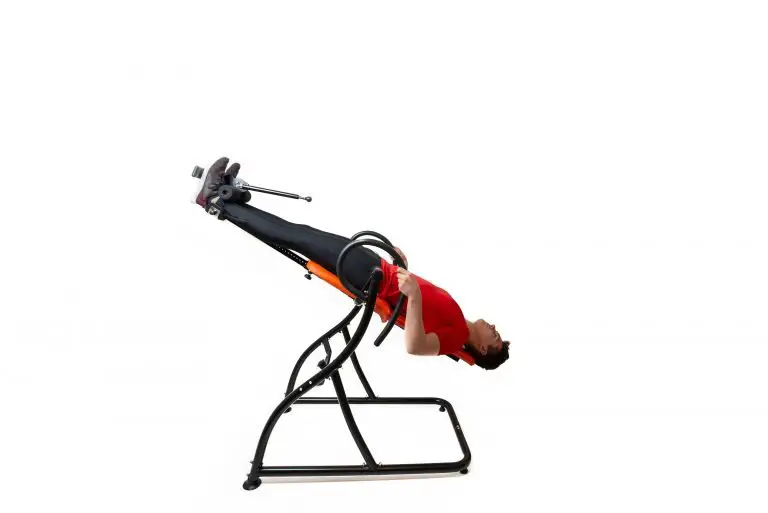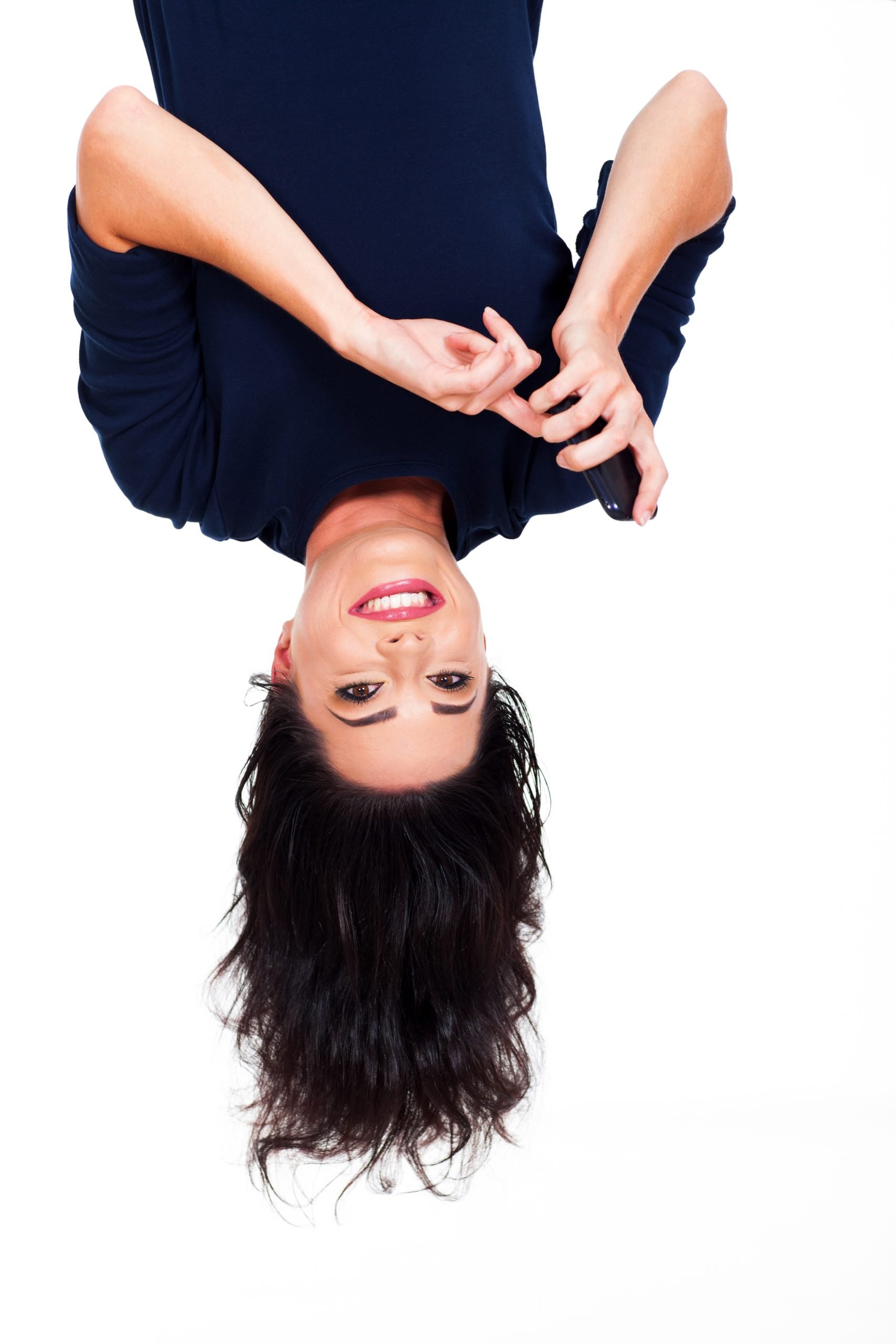
Page Contents
If you have heard of inverting for hair growth, then you have likely read things that claim you can grow your hair out as much as an inch per week by inverting daily. However, while entirely possible, those results are not the norm.
While inverting can make your hair grow faster, there are a few factors that must be considered. As with any hair growth tip, some people will simply not have the same results that others can get. Still, inverting is something that is well worth looking into if you want a simple and natural way to grow out your hair.
What Is Inversion?
Sometimes hanging upside down can be something fun that kids do from monkey bars or tree branches in the park. Some kids love being upside down on almost anything that they can possibly get in an upside-down position on.
Simply put, inversion is simply getting yourself into an upside-down position that puts your head lower down than the rest of your body. This helps the blood get pumped easier to all parts of your head. Your brain is undeniably one of the most important parts of your body, and it is already one that requires good circulation.
Because of this, your circulatory system has developed a way to push the blood up against gravity to your hair. As you age, this becomes harder for your body to do. This leads to a decrease in blood to both your brain and your scalp.
On its way back down, your blood gets to work with gravity as it returns to your heart and lungs. By turning yourself upside-down, you reverse this work. Your blood easily goes down to your head and then has to work back up to your heart.
Forcing your blood to work to get back to your heart means that it is not able to pass as quickly through your head. The blood, therefore, has more time while in your head to deposit its nutrients there. This means that while you are inverting your whole head, including your scalp and brain, get an increase of oxygen.
This is also why you often feel a strange ‘rushing’ sensation if you invert yourself too quickly. The blood that was having to be pushed up to your head is suddenly working with gravity instead of against it. Sometimes there is also a slight feeling of pressure too, as your body adjusts.
Inversion Methods

There are a variety of ways to invert. Some of these ways involve a specialized piece of equipment, while other ways don’t require you to have anything. Also, some inversion methods put your head lower down than other methods do and are, therefore, more effective.
For example, one inversion method that is simple and easy involves using a chair but does not invert you much. Sit yourself on your floor in front of a chair and then put your feet up in the chair while the top part of your body lays on the floor.
This puts your head lower than your feet, but still even with your torso. You can use a pillow or two under your hips while doing this. Doing so makes your head lower than the rest of your torso and give you a better effect.
Alternately, you can try sitting in a chair with your knees apart and hanging your head down between your legs. This is perhaps the easiest inversion method, and it is not as prone to making your dizzy thanks to the fact that not all of your body is above your head.
A headstand or a handstand is another way that you can invert yourself. However, in the case of a headstand, this can put a strain on your neck muscles. Holding a handstand for a few minutes can put a strain on your arms, but leaning up against a wall can help.
Perhaps the best method for inverting is using an inversion table. This requires you to buy an inversion table, though. Sometimes inversion tables can be quite expensive, but sometimes you can get a used one for cheap.
How To Use Inversion For Your Hair
Once you have your inversion method decided on, you need to plan out how often and how long you plan on inverting yourself. If you are not used to inverting, you may need to take it extra slow the first few times.
Get yourself into your inversion position gradually if you can, not all at once. Hold it for anywhere between 1 to 2 minutes to a full 15 minutes. For the first couple of weeks of inverting, stick with 1 or 2 minutes. You should especially do this slowly if you are not accustomed to being upside down.
After that, you can gradually increase your time inverting. You do not have to work up to the full 15 minutes. For growing your hair, 4 to 8 minutes is usually quite sufficient. You may not even be comfortable with going that long.
Some of this will also depend on the angle and how much you are inverting. For example, a handstand will put you at more of an angle than putting your feet up in a chair. The handstand will, therefore, be more uncomfortable sooner.
As you get up from your inversion, take it slow. You will likely feel a little dizzy, so brace yourself for it. Deep breaths can often help with this. You can choose to invert once or twice a day, or you can invert every other day, or even weekly.
However, your scalp can eventually get used to inverting if you do it too much or too often. For growing your hair, inverting twice a week or so is usually quite adequate. You can invert daily for hair growth, but this will allow your body to adjust faster, and you may stop seeing the growth results you are looking for.

Inversion Hair Add-Ons
While inverting itself can be great for your hair, there are a few things that you can do in addition to inverting. These things are entirely optional but can help you get the most out of inverting to help your hair grow.
Oils
Essential oils of any type, or other oils, are great to put on your scalp when you invert. If you are already using essential oils on your scalp, applying these while you are inverting will let you get the most possible out of the oil.
Thanks to the increased blood to your scalp, you will be able to absorb more nutrients from the oil. Almost any natural, non-scented oil will work for your hair. However, you will get more out of an oil that has known benefits for your hair.
Some good options include: coconut oil, jojoba oil, olive oil, castor oil, lavender essential oil, or rosemary essential oil. You can even use a personalized combination of multiple oils on your scalp if you prefer. Warm up whatever oil you choose before you get started.
Warm oil will bring your blood to the surface even more, helping with the absorption. You do not need it hot, just warm, and 2 to 3 tablespoons of it – only a few drops of essential oils. The best way to warm up the oil is to put what you need in a small container.
Place the container of oil in some hot water to let it heat up through conduction. While you can heat up the oil in a microwave, this is not advisable. First, it is too easy to overheat oil in a microwave. Secondly, it is also harmful to the nutrients in the oil – nutrients that you want for your hair.
Once warm, rub the oil into your scalp and massage it in thoroughly right before you start your inversion. You may need to use a comb or brush to get the oil to all parts of your scalp if you have long hair.
Deep Breathing
If you are inverting yourself in an uncomfortable position, then you may end up tensing up your muscles. This will not help your blood flow, so you should try to relax as much as possible while inverting.
Deep breathing is not only very relaxing, but it also helps with your circulation. When you breathe deeply, your diaphragm expands and completely fills your lungs with air. More air helps more oxygen to get into your blood.
Meditative breathing is a great exercise that you can do while you are inverted. One method, in particular, called square breathing, is simple and effective. For this, you breathe in for 4 seconds, hold it for 4 seconds, breathe out 4 seconds, and then hold it out 4 seconds before repeating it all over again.
If you want to, you can try to make the whole inverting experience as relaxing as possible. Pick a relaxing song that is just the right length of time to last for while you are inverting. Meanwhile, dim the lights and consider lighting a candle with a relaxing fragrance.
Massaging Your Scalp
Depending on the specific method you are using to invert yourself, you can use your free hands to massage your scalp. You do not need to apply oils to your scalp to massage it. You can also massage your scalp however you want to.
Some people prefer the feeling of using their fingertips to massage their heads. However, if you are a woman with long nails, you may have to massage your head with either your knuckles or the palms of your hands.
Any of these are fine, just be sure that you are not applying too much pressure. After all, you do not want to inadvertently hurt your follicles. You should focus on rubbing your scalp in the areas where your hair seems the thinnest at.
While you should give these problem areas more attention, you should go over your entire scalp as much as possible. Alternate between rubbing clockwise and counterclockwise and between large and small circles.
Related Reading
Hair Benefits Of Inverting
The benefits of inversion include helping with your hair, but there are more than this. Some of the benefits include getting your energy back and, depending on your method, helping you with your back pain.
Since you are here, then you are likely more interested in how inverting can help your hair. Your hair follicles need a good flow of blood to it in order to grow. Without a good blood flow, your hair follicles do not get the oxygen, vitamins, or nutrients needed to make your hair cells.
Every day as you go about your usual activities, your hair follicles are far above your heart. This elevation makes it that much harder for the blood to get to your follicles. Not getting enough nutrients can starve your follicles, slowing down your hair growth.
However, having a good blood flow to your hair follicles can even help with seemingly unrelated causes of hair loss. One study done on pattern baldness showed that the men who were suffering from pattern baldness all had lower levels of blood flowing to their scalps.
This is possibly because a better blood flow helps your body to clean out the DHT responsible for pattern baldness. By helping nutrients get to your follicles, inversion can help with virtually any cause of hair loss that affects you.
More than that, inverting can make you feel better in other ways, such as giving you more energy. This extra energy, in turn, can make you go outside more and help you be more active. This activity gets your blood pumping and gets you more Vitamin D, which is also good for your hair.
Though the other benefits to your hair that you can get through inverting may be indirect, they are still helpful. Every little help for your hair growth is nice.
Cautions Of Inverting

While inverting is great and has a lot of potential benefits, there are a few cautions as well. Inverting too much too often can potentially clog up your pores in your follicles. This will inhibit your hair growth, not help it.
Short periods of inverting are good for your hair, but long periods can cause your blood pressure to spike. In extreme cases, your blood pressure can spike high enough for you to have a stroke. Or, it is even possible for some blood to start pooling in your lungs or brain.
Obviously, none of these are things you want to happen. Certain medical conditions can make it riskier to try inverting. Anyone who has blood pressure problems or heart problems should probably not consider inverting.
Also, certain eye problems as a detached retina or glaucoma can be worsened by the increased pressure in the head. The same goes for ear problems such as ear infections. Vertigo can also be a concern when inverting. If you get dizzy, faint, or get nauseous, you should stop inverting immediately.
Pregnant women, and people who have certain types of back injuries, should talk to their doctor about inverting. Also, women who are on their menstrual cycle may find that inverting negatively impacts their cycle. Sometimes this makes them bleed more during this time.
Finally, if you are concerned about inverting, you should much sure that you have someone nearby. This person can be there to assist you in regaining your balance as you get upright again.
Final Thoughts
Inversion is one way in which you can increase the blood flow to your scalp to grow your hair. However, there are other approaches that you can use to try to achieve this result. The whole purpose of ingredients such as minoxidil is to do this exact thing.
Buying these hair products is a lot more expensive than simply inverting. Even buying an inverting table, which is a one-time cost, can be cheaper in the long run than buying hair products that you have to keep taking.
So, while inverting has some risks and cautions of its own, it can be the better choice in some cases. More than that, inverting can help you with other problems that involve your back and shoulders. The fact that your scalp can get used to the new blood flow over time does mean that you should take breaks.
After a few weeks of inverting, take a few weeks off before resuming it again. The fact is that no studies have been done on the effects of inverting on hair growth. That said, one small study done in 2016 did show that massaging one’s scalp did result in thicker hair.
If inverting is worth trying, it is up to you to decide. There are many benefits to inverting, and few disadvantages or concerns.
Not all hair growth solutions work well. Check out our list on the top 3 hair growth products and save yourself money, time, and best of all – hair!






